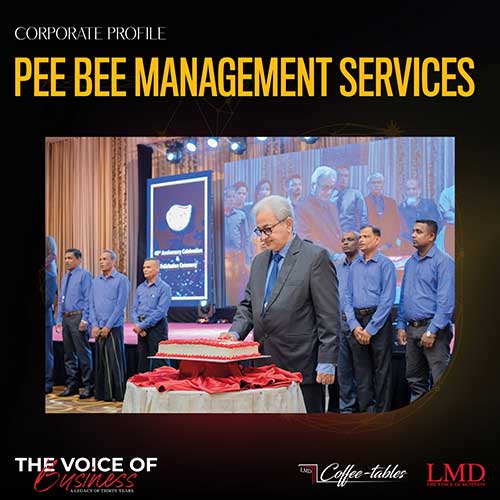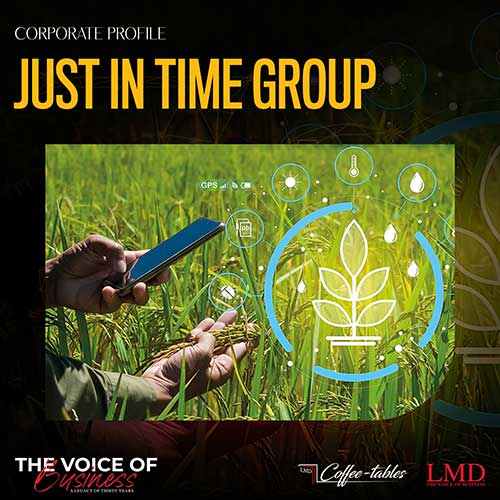REFLECTIONS
FROM THE SECOND DECADE
A selection from LMD’s Cover Stories
NOVEMBER 2004
FIGHTING TO SURVIVE!
Ashroff Omar – the Chief Executive Officer of Brandix Lanka – strikes a positive note about the immediate future of the apparel industry, in an exclusive interview with Darshana Abayasingha
 Q: What is the biggest challenge facing Sri Lanka in the quota free era?
Q: What is the biggest challenge facing Sri Lanka in the quota free era?
A: The biggest challenge for us is to retain and grow our apparel exports… The industry strategy was to double our exports in five years. That was two years ago. In order to reach that target, we are supposed to grow at a compounded rate of 12 percent every year. We have been growing at around six to seven percent so that’s where we are on our trek to the US$ 4.5 billion annual export mark. I don’t think there is one single biggest challenge: there are several aspects that would determine whether we will make it or not.
Q: Though the industry targeted an annual growth rate of 12 percent, you say it has only managed six to seven percent. What are the reasons for this?
A: Business reasons… Some sectors did well and some didn’t. If you take the previous 10 years, there was a compounded growth rate of around 18 percent.
The industry felt that it should bring that down to 12 percent. In the two years preceding the mooting of our strategy, the growth rate was almost negative. It remains to be seen whether we would achieve that number next year.
Q: How have the key stakeholders prepared for the changes and challenges of 2005 and beyond?
A: Many preparations have been made especially within many of the bigger groups. If you look at a profile of the industry, you will find different segments. One is the big Chinese exporters who are here. They are multinationals from China and Hong Kong who have decided to spend on their infrastructure here and build their businesses. There are several companies in this segment.
Take the locals: what we have done is to go into backward integration. We have invested in the fabric supply chain, knitted and woven goods, embroideries, buttons, elastics and printing among others. Much preparation has taken place. The most important thing that we have done is to build very good relations with our customers.
Q: We often speak about the threats that exist in the post-MFA period; but what opportunities does it offer?
A: The opportunities are greater. If you scan the industry, you will find that there are many countries involved – and obviously, China can’t take everything. China will be restrained like it was earlier, and nobody in their right mind would put all their eggs in the Chinese basket. At the same time, India has its own challenges.
Just take away China, India and maybe Indonesia, and look at all the business that goes on, starting from Europe: Turkey has a huge textile market with very high wages and so does Italy.
The Middle East has a huge base with zero competitive ability. Countries like Mauritius, Singapore and Malaysia all have very high wages. All those businesses account for billions of dollars in textile exports. So they will also be very worried as to how they are going to control their markets.
At a conference held recently in Bangkok, Nepal made a presentation. People are buying apparel from Nepal… Why? Because of the quota system. If it loses its quota, where would the customers go? Either to Bangladesh or India – or to Sri Lanka. These are the opportunities. What Turkey is exporting at five to six hundred dollars a month wages, we can provide.
Q: Which stakeholders can play what role(s) to help Sri Lanka survive ‘2005’?
A: I think all the roles that could have been played have now been played. Now we are running into the field. So ‘doing weights’ today won’t help. By now, we should be ready and we must start playing the game in a very agile manner. I think what the stakeholders could do – instead of running away – is to fight… We will have to fight one-on-one with our competitors.
Q: Is there a likelihood of any players thriving in the era immediately beyond 2004?
A: I cannot predict that, as it depends on the individual businesses. The opportunity not only to survive but to grow is there. How good we are at using that opportunity, only time will tell.
There are companies that are still undertaking tailoring jobs, which don’t have compliant factories and which are merely existing because they earned a fat quota. They could be shoddy in their workmanship but can still bat along. Those companies definitely are the first ones at risk. But the threat is the same for everybody. None of us can take it lightly.
Right now, people are euphoric because business – at present – is very strong. The numbers released for July this year were eight percent above the corresponding period last year. I believe the last few months of 2004 would also be much better than last year.
So today, if you talk to some people, they will say this is just like Y2K – only scare stories – and that nothing is going to happen. I think that if we are not ready and if we don’t keep at it, it’s going to be a very rough ride for us.
Q: How effective has the government’s ‘Washington lobby’ been in staving off the crisis?
A: There were some delays with the changes here and there. The ‘Washington lobby’ – even after the change of government – is driving it hard. So the relationship with Washington, I believe, is excellent. But now, we have to wait and see what happens in the US election.
Q: Has the ongoing political instability in Sri Lanka been a stumbling block to achieving the goals of the apparel industry?
A: The argument is that if there was no change, we may have heard the announcement of a free trade agreement. But political changes will take place. What I am saying is: what has happened has happened and it is done with; we must move on. We can’t say that because of political changes, everything has collapsed.

Q: What role did the Joint Apparel Task Force play in the apparel industry’s national strategy?
A: We have nine or 10 committees in the task force and each one is engaged in different activities. One is looking at human resource development, the other at infrastructure development. We are trying to provide assistance in every way we can… We don’t have one silver bullet. It’s a multitude of factors. We are exporting 2.5 billion US Dollars’ worth of many types of apparel to various customers in different markets. So you can’t say that if you reduce wages by 20 percent, we will survive. We are trying to work around everything.
Q: What kind of expectation does the industry have as regarding government support?
A: We have about 60 items to be addressed, which we are now working on with the National Council for Economic Development. During our meeting with the president, we will take up three or four key issues that we believe could make or break the industry.
NUMBER ONE We will be pointing out that there should not be any additional burden, at this crucial juncture, placed on the industry – for instance, the Economic Service Charge. This should not be implemented – at least until we get an FTA or some other safety net in place. There has also been a request to remove the ports and airport levy, which we have been told will be done.
NUMBER TWO We have not been able to do much for small and medium enterprises (SMEs). Their biggest problem is collateral in borrowing. If they don’t borrow, they cannot upgrade. If they don’t upgrade, they are doomed. So we are requesting the government to provide a credit guarantee scheme for SMEs so that they can get loans faster.
NUMBER THREE An FTA with the European Union (EU). We are asking for special duty concessions under the Generalised System of Preference (GSP). Today, we have a 40 percent discount on duty if we use regional fabric. That is divided into two. We get 20 percent as a normal GSP and an additional 20 percent because Sri Lanka’s labour practices have been recognised by the EU.
We want to ask the EU to turn that 20 percent into a 60 to 80 percent cut. The response of the Europeans could be that everybody might ask for this. But fortunately, only two countries in the world enjoy a labour GSP: Sri Lanka and Moldova. So we want to ask the president herself to lobby for this cut.
NUMBER FOUR Backward integration. Textile plants want to go into zones where they don’t have to invest huge sums in water treatment. What we are saying is to reserve phase two of the Biyagama Free Trade Zone for textiles with the pre-treatment plants among other facilities.
NUMBER FIVE We need to enhance the image of our apparel workers. Somebody once told me that when the girls don’t study in school, they are told that they would become a jukiya (a garment factory girl). So that’s still a stigma. What we believe is that these girls are performing the most honourable task for their country. The public should recognise them as people who contribute immensely to the economy, instead of degrading them.
Q: Does the government have a contingency plan in place?
A: They should… We are also going to recommend that the funds provided by the IMF be used in case of a disruption to relocate and train personnel. That would be our fifth strategy: for the people who are not ready to be helped to move out so that there won’t be any serious social issues.

Q: What role do you think the business community or any other stakeholder could play in order to help the industry move forward?
A: I don’t believe in the fact that the business community would get together and say ‘let’s help the garment industry.’ Businessmen are there to make money and the day a businessman is not there to make money, he stops being a businessman. I think everybody must look at business opportunities.
As a country, we are importing about 1.5 billion US Dollars of merchandise. So there could be investment from other sectors… If every industrialist or new investor says ‘I will invest in this because we are importing 50 million US Dollars’ worth of an item, I will set up a plant that would bring 20 million US Dollars in turnover, and offer a better price and service,’ that’s the type of infusion – of taking the opportunity – that other businesses can make. The tourist industry can make a big pitch, for example; because when they are positioning the country, we should also be there with them, reinforcing the image of a ‘sweat-free country.’
Q: There has been a suggestion to create a ‘Sri Lanka Incorporated’ brand, as in the tea and tourism industries. Do you think this could perhaps be the way forward?
A: In the longer term, yes. At the moment, the thought process behind that is you drive the consumer to demand ‘Made in Sri Lanka’ items. That’s the goal. But that’s a very expensive process and at the moment, we don’t have the funds.
My brief to the head of our marketing and image building programme was: there are perhaps – at most – a thousand people in this world who will decide whether Sri Lanka can grow or not. They have to be convinced that we are a viable case. Target those people: it’s cheaper and we have the means to target them.
To target the whole of the US and the EU to promote ‘Sri Lanka Inc.’ is a very good idea – but that will take time and money. You go to America: most of the people have not even heard of Ceylon or Sri Lanka. So while we are talking about Sri Lanka Inc.’ as an apparel base, it’s much faster if we can do that with our tea – and we will make much more money than we do on apparel as a country.
Q: How ready are the SMEs for the post-MFA era and has backward integration helped them in any respect?
A: Their state of readiness varies. I met some people recently who said that they have orders till next June while others are very fearful. Nobody can be a prophet – either of good tidings or of doom. Market dynamics change so fast. A lot would depend on how the US and the EU treat China.
The way I see it is that everybody has tried but people have worked to varying degrees. Some people have done nothing while others have done a lot. And backward integration has helped to some degree. It still is very small in this country – and we produce only 10 or 12 percent of what we need. But there are a lot of people who have established good contacts with Indian fabric mills, for example. And again, the argument is if India is growing, why can’t Sri Lanka?
Q: Do you think that some of the smaller players could be brought under the umbrella of the larger companies?
A: A lot of people are already doing that. We have many suppliers, and I am sure that they are also supplying Smart Shirts and they may also be supplying the MAS group – again, these are business decisions.
Q: But there have been allegations that the bigger companies have not done enough to look after the interests of the smaller players. What is your response?
A: That allegation will be there throughout! We accept, even at the Joint Apparel Associations Forum (JAAF) – and I feel very sorry about this – that what they need is good collateral: they need ‘aggressive lending.’
But we can’t blame the banks for being cautious, and that is where the government must step in and see to it that the smaller players get the funding.
Some companies will still fail. But I think it would be a big boost overall.
Q: Is there any particular marketing thrust that the country could adopt especially to compete against countries such as China?
A: We are trying to create an image of the country for a targeted audience: that we are ‘sweat-free’ and compliant and that our trade policies are open among other attributes. The individual firms have to do the marketing.

Q: Do you think that the Sri Lanka Apparel Exporters Association (SLAEA) and JAAF have done enough to look after the smaller players?
A: The small players have their own association and they are a part of JAAF… When we put down our ‘wish list,’ everybody wanted loans to be granted, and support and funds to go overseas to meet the buyers.
So it depends on the degree. I am disappointed that we have not been able to fix this collateral issue. But I don’t think that any day, anybody could say “enough” – because, always, more could be done…
Q: Some companies have set up operations overseas. Could this be one survival strategy?
A: Bangladesh was a strategic investment for the Hirdaramani group, for example, to buy cheap products and supply.
We went to the Maldives because of quota. With the quota system coming to an end, we are bringing it back. We have invested in Madagascar, as it is a duty-free country – and this operation we are continuing and expanding. We are also looking at India and China. This industry will move where the best options are.
Q: What are the competitive advantages that companies could use to grow beyond 2005?
A: In our view, you must be a ‘category killer.’ If you say you are making shirts, can you be the world’s largest shirt maker? Can we give customers a compelling reason to come to us and buy? Whether we can do it depends on our skills and how smart we are. That creates an opportunity to try and become ‘category killers.’
Q: Is there a future for buying operations in Sri Lanka?
A: Certainly. If our laws become more and more liberal, why should all the buying centres be in Hong Kong? They should be in Sri Lanka to service India, Pakistan and Bangladesh.
Q: Are strategic alliances a way forward in the post-quota era?
A: Definitely. You have to tie up. Sri Lanka’s biggest advantage today is that all the top brands are here. We are visible and we are big on the apparel world’s radar screens. I think that’s definitely one of the simpler ways forward.
Q: What exit strategies would companies adopt?
A: Exit strategies are obviously to try and keep enough funds to settle your workforce, and perhaps sell your plant to companies that are willing to take them over and run their operations.
At some places where factories are located, the land value is phenomenally high.
So they could relocate and ensure that there is enough money to pay compensation and take care of the banks. We don’t have any major industry other than tourism, which is moving at the moment, to send the workforce that comes out of here to retrain and go into the service industry.
But the numbers in the apparel industry are more difficult to replace: that’s why it’s so important to the economy.





